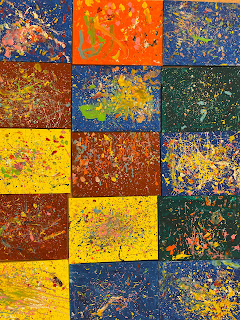A significant part of who we are is sum of all the big and small actions that we make on a daily basis. Our movements are what we use to navigate our way around the world -- they help us to survive, to thrive, to communicate, to build relationships, and even to express ourselves.
In the world of art, movement has always played a central role. From classical paintings to modern installations, artists have used movement to convey emotions, tell stories, and create dynamic works of art.
This week, the kindergarteners explored, experimented, and experienced how to become artists and storytellers through movement, which they preserved using different forms of media.
MOTION PAINTING
One of the most basic ways that movement can be incorporated into visual art is through the use of dynamic lines and curves. Artists use these elements to create a sense of movement and flow in their work, conveying emotions and creating visual interest.
For example, the works of Pablo Picasso and Joan Miro, with their flowing lines and dynamic compositions, convey a sense of movement and energy. This can also be seen in the works of abstract expressionist artists like Jackson Pollock and Willem de Kooning, who used sweeping brushstrokes to create a sense of movement and energy in their paintings.
In class, we tried to capture motion the way famous artists did it, but we incorporated some twists in the process to make it more fun and exciting for the children.
Using Marbles
What if instead of paintbrushes, we used marbles to create lines and shapes in our painting?
Painting with marbles is a fun and unique approach to art-making that involves using small round objects to create interesting patterns and textures on a surface. The random movements of the marbles as they roll through the paint can produce unexpected and captivating results, adding an element of surprise to the creative process.
Look at their finished products!
Using Sponges
Have you ever had the freedom to throw things on a canvas and create something amazing? I can imagine the process to not only be fun but also cathartic.
Sponge painting is a form of abstract expressionist art that involves physically flinging or splattering paint onto a surface, such as a wall or canvas, to create a dynamic and spontaneous work of art. This type of art allows the artist to fully embrace the creative process and let their emotions guide the creation of the artwork.
Using a Pendulum
What if we use science to create art? What will the outcome be?
Pendulum painting is a form of art-making that involves using a pendulum to create marks on a surface, such as a canvas or paper. The basic process involves attaching a marking tool to the end of a string, swinging it back and forth to create marks, and letting gravity dictate the movement of the pendulum.
One of the benefits of pendulum painting is that it allows the artist to step back and let the pendulum do the work. This hands-off approach to painting can result in surprising and unexpected patterns and shapes, and can be a great way to loosen up and try something new.
Using Light
How can you capture light to create a painting?
Light painting is a form of photography that involves using a moving light source to "paint" a scene in the dark. This is typically done by leaving the camera's shutter open for a long exposure, allowing the light to be captured as it moves through the scene.
We transformed the playhouse in our classroom into a dark room, which we used for "painting" with glow sticks.
Koh
Emma C.
Kennosuke
Sarah
Kallea
Emma I.
Haruto
Hana
Yorinobu
Zoey
Kanato
Chanin
Tamaki
Clara
"This is a party room, Ms. Pam! It's so fun!" they said. 😆
Using a Paintbrush
What will happen if you paint without letting the paintbrush touch the canvas?
Drip painting or action painting is a form of abstract expressionist art that involves the artist dripping, pouring, or splattering paint onto a canvas to create a work of art. This technique was popularized by the famous American artist Jackson Pollock in the 1940s and 1950s and has since become one of the most recognizable styles of abstract expressionist art.
One of the key features of this technique is the use of chance and unpredictability in the creative process. The artist often works on the canvas from all sides and uses a variety of tools, including brushes, sticks, and even their hands, to apply the paint. The resulting works are characterized by bold, gestural brushstrokes and drips, creating a sense of movement and energy in the artwork.
Movement is an integral part of our life.
If movements are considered an art form, then it goes without saying that we are all living, breathing, and moving forms of art.
Our artistry through our motion makes the world a beautiful place.
Have a wonderful long weekend, everyone.
Your Kindergarten teacher,
Pam












































































Thank you so much for your such beautiful and exciting art classes!!!
ReplyDeleteKids have so unique and special experience with you always. We are looking forward to seeing all arts at an exhibition